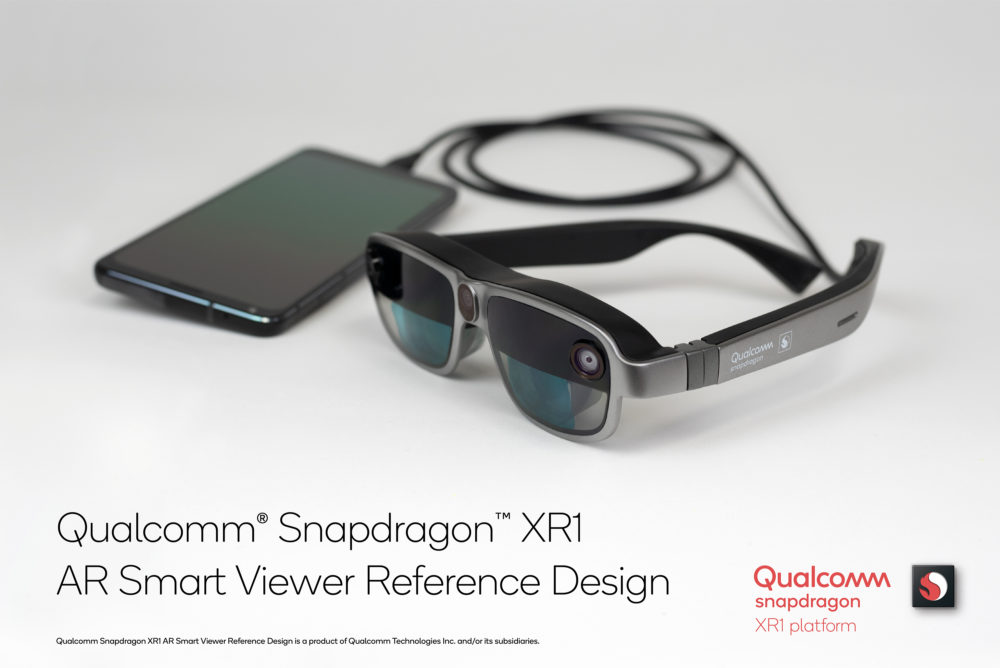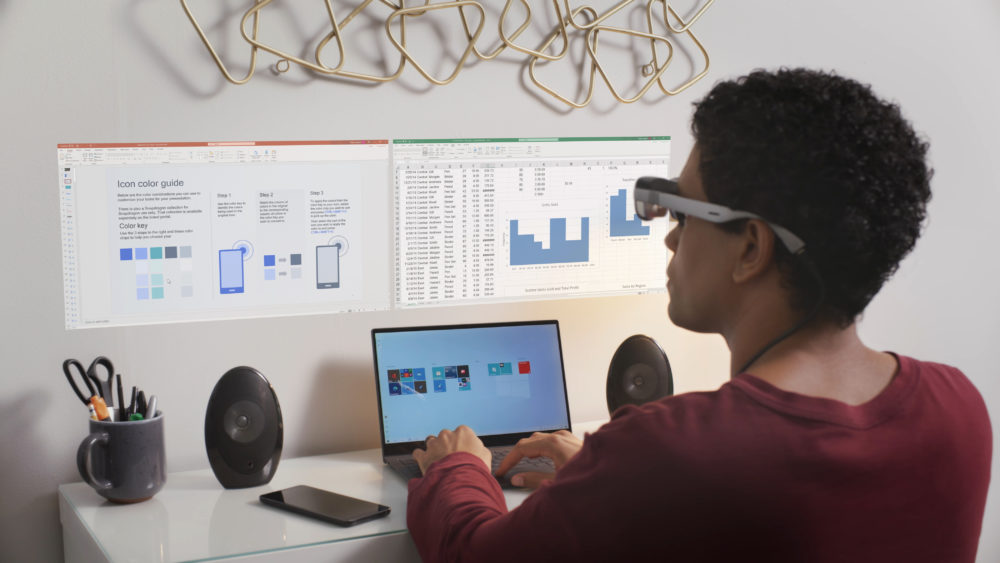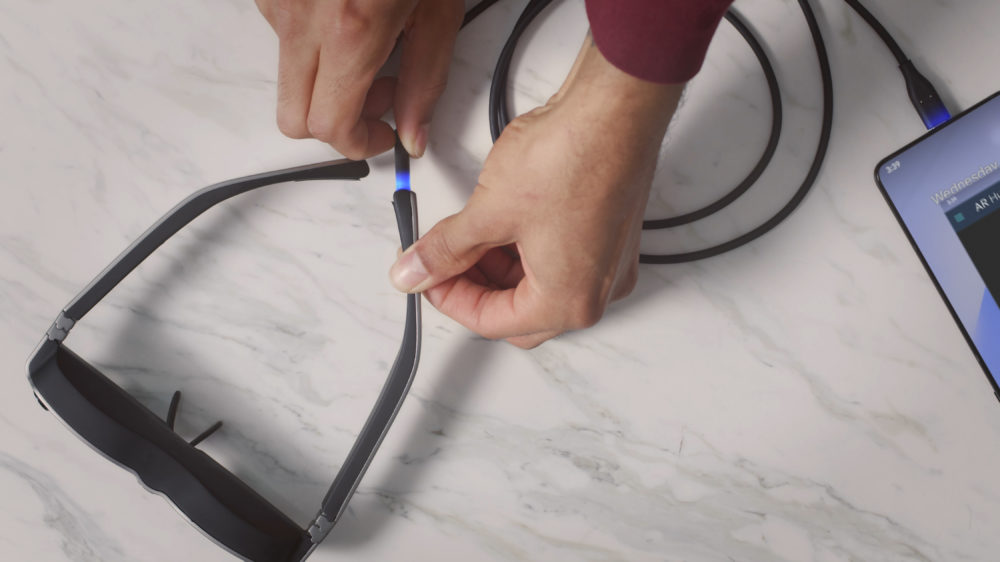In Augmented Reality and Mixed Reality News
February 23, 2021 – Qualcomm Technologies, Inc. has today introduced its first augmented reality (AR) reference design based on the Qualcomm Snapdragon XR1 Platform, equipped to deliver high-performance, immersive experiences, and lower power consumption. The reference design is an AR smart viewer with versatility to tether to a compatible smartphone, Windows PC, or processing puck and is optimized for devices powered by Qualcomm Snapdragon Platforms.
“The Snapdragon XR1 AR smart viewer marks a new chapter for our reference design portfolio and a big step in the evolution of AR viewers,” said Hugo Swart, Vice President and General Manager of XR at Qualcomm Technologies, Inc. “AR simple viewers showcased viewers as an accessory to a smartphone. Now, AR smart viewers allow us to move some processing to the glass, to expand the possibilities of use cases, applications and immersion—this reference design is the first step in our roadmap to help scale the AR industry.”

The AR smart viewer features processing power in the reference design in order to help distribute computing workloads between the viewer itself (referred to throughout as “the glass”) and the host device, compared to what the company refers to as an ‘AR simple viewer’, which does not have any processing capabilities on the viewer. Qualcomm states that its AR smart viewer reference design packs significant performance features and premium use cases for both the enterprise and consumers, including:
- Split-processing that enables the AR smart viewer’s on-device optimization to deliver a 30% reduction in overall power consumption on the system;
- A 2D app framework that provides a systems-level feature that helps launch smartphone applications into multiple virtual displays that can be anchored within a user’s environment. The framework also supports protected content viewing, allowing users to watch premium movies and streaming services with the smart viewer;
- Tethering to a PC, the smart viewer combines plane detection and the ability to render multiple virtual displays to allow virtual PC windows to be anchored to planes in the real world;
- Support for an 8MB RGB camera with image stabilization on the AR smart viewer will help to deliver hands-free and “See What I See” use cases such as remote assistance;
- Dual monochrome cameras on the smart viewer enable six-degrees of freedom (6DoF) head tracking and hand tracking with gesture recognition.
In the reference design, BOE, which Qualcomm partnered with in April last year, provides a micro-OLED binocular display, that allows frame rates to achieve up to 90 Hz and a no-motion-blur feature to deliver a seamless AR experience, according to Qualcomm. The AR smart viewer hardware, developed by Goertek, enables manufacturers to quickly scale and develop smart AR devices for commercial use.

At a press briefing for the announcement held in VR app Spatial, Swart added: “Customers that follow our reference design will now have a more simple cycle for development. The reference design is not something that we commercialize, we just make it available to our customers in order to help them go to market and lower their investment and development costs.”
Developed in parallel with Qualcomm’s AR smart viewer reference design, Lenovo recently unveiled its ThinkReality A3 powered by the Snapdragon XR1 Platform. Designed as an advanced and versatile enterprise smart glasses solution that will come to market starting mid-2021, the ThinkReality A3 provides virtual monitors and 3D visualization to AR assisted workflows, as well as immersive training to help transform work across many levels of the enterprise.
Chi Xu, founder and CEO at Nreal, a longstanding Qualcomm viewer partner, commented: “With the global deployment and success of our Nreal Light device, we are committed to delivering more content and innovative user experiences in the future.” He added, “Split-processing between a glass and smartphone or host device unlocks a new type of immersion and we look forward to working with Qualcomm Technologies to drive that roadmap.” Nreal is also apparently working on its own smart viewer device.

According to Swart, the future will involve having some processing on the glass itself, but not all of it. This is mainly due to the power constraints of small form factor eyeglasses. The next logical step is going wireless from the phone to the glass, but once you do that, you do require processing in the glass. The smart viewer reference design is therefore part of this journey from simple viewers (such as the Nreal Light) to true smart glasses.
Swart noted that wireless smart viewers are likely not that far off, and said: “although 2021 is not impossible to see wireless smart viewers, I think It’s tough. It is probably more likely to be in 2022 before we start to see wireless viewers”.
The company too is working on wireless, but in two segments. One is from the glass to a phone or host device, and the other is from the phone/host device to the cloud. Ultimately the end goal is to have all of the heavy rendering carried out on the cloud, with a smart glasses-style device then able to receive the information over wireless (5G or 6G). This is still going to take a long time before the technology is capable of doing this though. The local link between the glass and phone does however mark a very important development towards this goal.
The Snapdragon XR1 AR Smart Viewer reference design is available for select partners now, with wider availability in the coming months. For more information, please visit The Snapdragon XR1 Platform product page.
Image / video credit: Qualcomm
About the author
Sam Sprigg
Sam is the Founder and Managing Editor of Auganix. With a background in research and report writing, he has been covering XR industry news for the past seven years.




